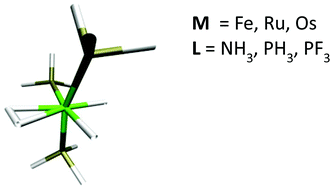First principles static and dynamic calculations for the transition metal hydride series MH4L3 (M = Fe, Ru and Os; L = NH3, PH3 and PF3)†
Abstract
We present a first principles static and dynamical study of the transition metal hydride series MH4L3 (M = Fe, Ru and Os; L = NH3, PH3 and PF3), with a view to arriving at an understanding of how the variation in the electronic properties of the metal sites and ligands can influence the dynamics of the resulting complexes. A broad range of behaviour was observed, encompassing stable classical minima (M = Os, L = NH3 and M = Ru, L = PH3) to stable η2-H2 non-classical minima (M = Fe, L = PF3 and M = Ru, L = PH3 or PF3), with the other structures exhibiting dynamical behaviour that spontaneously converted between the classical and non-classical states during the molecular dynamics simulations. The importance of a small Laxial–M–Laxial angle in stabilising the non-classical state is highlighted, as is a short η2-H2⋯Hcis distance in non-classical complexes that spontaneously convert to the classical form. We also investigated the changes in the electronic structure of the complex FeH4(PH3)3 during a η2-H2 bond breaking/bond making reaction and observed direct evidence of the ‘cis effect’, whereby a neighbouring hydride ligand acts to stabilise the intermediate classical state.


 Please wait while we load your content...
Please wait while we load your content...